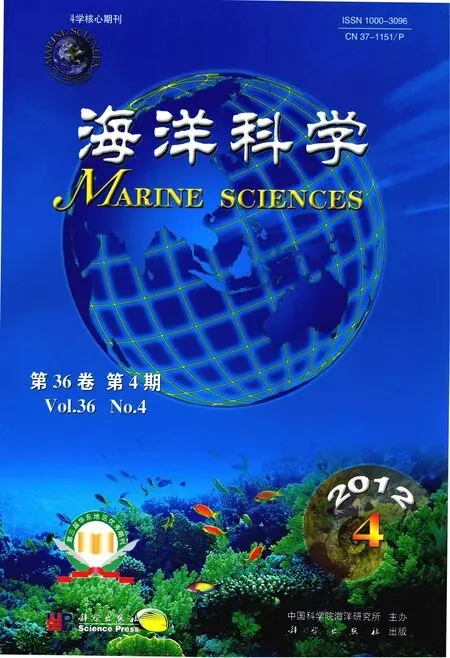持久性有机污染物对藻类生态毒理研究进展
曲 莹,周海龙,董 方3,薛钦昭
(1.中国科学院 烟台海岸带研究所,山东 烟台 264003;2.海南大学生物系,海南 海口 570228;3.中国科学院 海洋研究所,山东 青岛 266071;4.中国科学院 研究生院,北京 100049)
随着人们对海洋生态系统保护意识的增强,很多学者对造成海洋污染的成因、机理、污染物对海洋生物的生态毒理进行了深入的研究[1-5]。近年来,持久性有机污染物(persistent organic pollutants,POPs)对海洋生物生理和生化过程的影响已成为该领域的研究热点。
1 POPs的发现及新型POPs记录
1964年,Jensen用气-液相色谱法从野生生物样品中分离有机氯农药,发现了一个未知峰[6],1966年这些未知峰被确定为多氯联苯(PCBs)。此后,陆续有学者发现 PCBs及其他有机化合物在全世界的海洋底泥、无脊椎动物、鱼及其他生物体内也有残留,至今已无处不在[7]。这类持久性有机污染物具有持久性、生物富集性、半挥发性和毒性,能在大气环境中远距离迁移并沉积,对人类健康和环境造成严重危害[8]。为控制POPs对环境继续造成污染,2001年5月,中国签署了《斯德哥尔摩持久性有机污染物公约》,对12种POPs的生产和使用加以限制。然而,随着环境污染日趋严重及各国学者对 POPs污染的研究深入,人们发现对环境安全造成威胁的POPs远不止这12种,如PBDE (polybrominated biphenyl ether,多溴联苯醚)、BDE (polybrominated biphenyl ethers,多溴二苯醚)、PFOS (peifluorooctane sulfonate,全氟辛烷磺酰基化合物)、PFOA (perfluorooctanoic acid,全氟辛酸)、2,4-DCP (2,4-dichlorophenol,2,4-二氯酚)等新型POPs陆续为文献报道。这些POPs是设计用来替代那些被禁用或过时的 POPs,或者是一些已经使用多年但近期才发现可以在生态系统中富集、危害可能性增大的环境污染物;新型POPs还有另一个可能的来源是存在于环境中的有机化学物质通过物理或生物降解成为毒性更大、更容易被生物富集的形式如PFO (烷基酚和全氟辛烷磺酰基化合物)[9]。
2 POPs在海洋中的广泛性和危害性
随着被认知的POPs种类的不断增加,人们发现POPs污染问题越来越严重。通过陆源排放和大气沉降等途径,释放于各种环境中的POPs最终进入海洋,使得海洋成为POPs的重要聚集地,海洋生态系统的稳定性也因此受到严重威胁,这一情况已引起全球学者对海洋污染物来源研究的重视。以硫丹污染为例,来自美国、澳大利亚和印度刚果河流域[10-13]的调查数据显示,径流从土壤中带来的硫丹可使其在这三个地区水域中的浓度分别升高到 13.4,45µg/L和66.5 µg/L,这些浓度已远高于对水生生物产生急性和慢性毒害作用的浓度 0.22 µg/L 和 0.05 µg/L[14]。很多种类的 POPs都被证明具有生物富集效应和生物放大效应[15-20]。POPs在海洋生态系统中随着食物链的延伸而迁移,最终将对食物链的最高营养级——人类的健康造成严重威胁。因此,国内外对于可供食用的海洋动物体内POPs浓度水平的研究较多[21-22],而POPs对藻类生态毒理研究部分则相对较薄弱。
3 POPs藻类生态毒理研究
藻类是整个生态系统物质循环和能量流动的重要基础,其本身的生长和代谢会直接受到POPs污染的影响,进而影响到初级消费者及高级消费者的正常生长和生理过程。藻类对于许多毒物比鱼类、甲壳类更为敏感,而且藻类具有周期短、易于培养、可以直接观察细胞水平上的毒性症状等特点[23]。利用藻类的这些生物学特点进行生态毒理学研究,有助于我们客观了解和准确评估 POPs对整个海洋生态系统造成的威胁,为阻断 POPs在食物链中的传递,降低和避免对人类健康造成的危害,为解决中国海洋环境POPs污染问题提供科学依据。
3.1 POPs对藻类生长的毒性效应
许多研究结果表明,在POPs暴露和胁迫下,藻类生长受到明显的影响。Delorenzo等[24]在研究中发现,绿藻(Pseudokirchneriella subcapitatum)在硫丹中暴露的 EC50浓度为 427.8 µg/L。在室内试验中,当PFOS的浓度高于50 mg/L时,羊角月牙藻(Selenastrum capricornutum)和小球藻(Chlorella vulgaris)的生长会被显著抑制[25]。但有些种类的藻在一定浓度范围内的某种POPs中还能正常生长。小球藻(Chl.fuscavar.vacuolata)和项圈藻(Anabaena varialilis)在有5~40 nmol/L浓度DNP存在的条件下能够正常生长并表现出较高的富集DNP的能力[26];小球藻(C.vulgaris)和Coenochloris pyrenoidosa在 24 h光照培养下, 5 d内在50 mg/L的p-chlorophenol和p-nitrophenol环境中能对两种有机污染物进行富集[27];扁藻(Tetraselmis marina)还能通过与葡萄糖共转移的方式将 2,4-DCP类化合物富集,从而降低其对藻体产生的毒性[28]。
3.2 藻类抗氧化酶防御系统对 POPs的响应
许多毒性物质的致毒机理在于能够诱导细胞产生大量活性氧(reactive oxygen species,ROS)而对机体产生各种损害,诱发细胞抗氧化酶系统活性增强,加快ROS清除过程。抗氧化酶系统涉及的抗氧化酶包括抗坏血酸过氧化物酶(APX)、超氧化物岐化酶(SOD)、过氧化物酶(POD)、谷胱甘肽过氧化物酶(GPX)、过氧化氢酶(CAT)和谷胱甘肽还原酶(GR)等。由于抗氧化防御系统对污染物胁迫相当敏感,因此在指示污染物胁迫的早期预警中发挥巨大的作用[29]。不同的POPs对同一种生物的抗氧化防御系统产生的影响不同,不同种类的抗氧化酶对POPs胁迫的响应也不尽相同。当金鱼藻(Ceratophyllum demersum)暴露于10 mg/L的1,2-DCP和10 mg/L 的1,4-DCP中时,GST活性显著增高;当二者的浓度达到5 mg/L的时候,POD和GR的活性就显著增强[30]。乙氧氟草醚(oxyfluorfen)和敌草隆(diuron)对斜生栅藻(Scenedesmus obliquus)的单独以及联合作用24 h后的研究结果显示:CAT、APX、GR和s-GST在乙氧氟草醚的刺激下活性增强,而敌草隆未对 3种酶活性有显著影响。乙氧氟草醚和敌草隆对S.obliquus的抗氧化反应具有拮抗作用,但在酶水平上,只能观察到对 CAT酶的拮抗表现[31]。通过对暴露于不同浓度的硫丹环境中水聚藻(Myriophyllum quitense)体内CAT、GR、s-GSTs和m-GSTs活性变化的研究结果表明,硫丹浓度为 0.02 μg/L(淡水中最大安全浓度)时未能引起M.quitense体内抗氧化压力升高,但在试验中设计浓度0.5 μg/L和5 μg/L 时抗氧化酶系活性都应激升高。藻类抗氧化酶防御系统对POPs与其他有毒物质的响应类似[32]。
3.3 POPs对藻类的毒性机制
目前,POPs对藻类产生毒性作用的机理还没有统一的定论,不同的研究结果显示POPs对藻类的毒性机制不同。首先,POPs的化学结构会对其生物毒性产生决定性的影响。例如,氯酚能够干扰细胞内能量转换过程,将氧化反应和光合磷酸化反应隔离或者干扰电子传递,从而对微生物产生毒害作用,其毒性随苯环的氯化程度的升高而增高[33-34]。硝基芳烃对藻体可能是通过亲核取代或氧化反应而致变的,毒性差异主要是受取代基的影响[35]。其次,有研究表明,单硝基取代物的毒性取决于其疏水性,而二硝基取代物的毒性取决于其电子属性[36]。另外,杜庆才等[37]对氯代芳香族污染物对羊角月芽藻(Selenastrum carpricornutum)的急性毒性试验结果表明,分子总能量TE是决定该组污染物毒性的关键参数,TE越高,反应活性越高,对藻的毒性也越大。除了POPs可能的致毒机理复杂多变以外,受试生物的不同也增加了致毒机理的不确定性。总之,POPs进入藻类细胞以后对细胞造成毒性损伤且很难降解[38]。
藻类所在生态系统的实际环境远比实验室条件复杂,很多理化因子如水分、pH和紫外线(UV)等环境因素也会影响有毒物质对其毒性作用。例如,UV可导致生物体内 ROS含量增加[39],同时,植物体内的PSII、蛋白质和DNA、膜系统以及植物激素均为UV作用靶,因此,UV和有毒物质的联合胁迫往往导致生物体受到更为严重的伤害。例如,蓝藻Plectonema boryanum遭受UV-B和Cd的联合胁迫后,CAT和SOD活性均增高,UV-B辐射使质膜透性增大,从而导致Cd吸收量增加,使得Cd对其毒害作用更强[40]。土壤镉污染也会加剧 UV-B辐射对一种云杉(Picea abies)的损伤[41]。但目前未见有 UV和 POPs联合胁迫对藻类毒理学的研究。
4 POPs对藻类生态毒理研究展望
前人的研究工作主要以藻类生境中 POPs种类和浓度定量描述、POPs急性和慢性毒理试验为主,试验的结果可以作为评价环境中 POPs毒性强度以及对海洋生态造成影响的参数之一,能够反映污染物对生态系统在整体水平上的影响,但是随着海洋环境污染程度的加剧和污染情况复杂性的提高,POPs对藻类的生态毒理研究还应在以下几个方面加强:
(1) 污染物对藻类毒害作用的本质、POPs与藻细胞中蛋白、核酸等生物大分子之间的互作影响研究。
(2) 结合现代生物学方法与技术如差减杂交、差异显示 PCR,利用基因在生物体内的差异表达量作为生物标记物,或找出POPs对藻类毒害作用的靶位点或靶分子,探索新的分子生态毒理学指标。
(3) 不同种类的 POPs、POPs与其他污染物、POPs与其他理化因子如紫外线、水分和pH对藻类的联合毒理作用研究。
(4) 用多项指标综合评价POPs对藻类的潜在影响,从而更有效地对POPs低剂量暴露的作用做出早期预警,对藻类个体、种群、群落和生态系统造成的环境影响做出更准确的预测。
[1]Storelli M M,Barone G,Storelli A,et al.Total and subcellular distribution of trace elements (Cd,Cu and Zn) in the liver and kidney of green turtles (Chelonia myda s) from the Mediterranean Sea [J].Chemosphere,2008,70:908-913.
[2]Capelli R,Das K,De Pellegrini R,et al.Distribution of trace elements in organs of six species of cetaceans from the Ligurian Sea ( Mediterranean ),and the relationship with stable carbon and nitrogen ratios [J].Science of the Total Environment,2008,390:569-578
[3]Jong I H D,Van Zelm R,Huijbregts M A J,et al.Ranking of agricultural pesticides in the Rhine-Meuse-Scheldt basin based on toxic pressure in marine ecosystems [J].Environmental Toxicology and Chemistry,2008,27(3):737-745.
[4]Gomez-Gutierrez A,Garnacho E,Bayona J M,et al.Screening ecological risk assessment of persistent organic pollutants in Mediterranean sea sediments [J].Environment International,2007,33:867-876.
[5]Mearns A J,Reish D J,Oshida P S,et al.Effects of pollution on marine organisms [J].Water Environment Research,2007,79:2102-2160.
[6]联合国环境规划署,世界卫生组织.多氯联苯和多氯三联苯[M].北京:中国环境科学出版社,1979.
[7]Katsoyiannis A,Samara C.Persistent organic pollutants(POPs) in the conventional activated sludge treatment process:fate and mass balance [J].Environmental Research,2005,97(3):245-257.
[8]Gouin T,Harner T,Daly G L,et al.Variability of concentrations of polybrominated diphenyl ethers and polychlorinated biphenyls in air:implications for monitoring,modeling and control [J].Atmospheric Environment,2005,39(1):151-166.
[9]Newman M C,Unger M A.Fundamentals of Ecotoxicology [M].second edition.北京:化学工业出版社,2006.
[10]Antonious G F,Byers M E.Fate and movement of endosulfan under field conditions [J].Environmental Toxicology and Chemistry,1997,16(4):644-649.
[11]Kennedy I R,Sanchez-Bayo F,Kimber S W,et al.Off-site movement of endosulfan from irrigated cotton in New South Wales [J].Journal of Environmental Quality,2001,30(3):683-696.
[12]Leonard A W,Hyne R V,Lim R P,et al.Fate and toxicity of endosulfan in Namoi River water and bottom sediment [J].Journal of Environmental Quality, 2001,30(3):750-759.
[13]Selvakumar S,Geraldine P,Shanju S,et al.Stressor-specitic induction of heat shock protein 70 in the freshwater prawnMacrobrachium malcolmsonii(H.Milne Edwards) exposed to the pesticides endosulfan and carbaryl [J].Pesticide Biochemistry and Physiology,2005,82(2):125-132.
[14]Mersie W,Seybold C A,McNamee C,et al.Abating endosulfan from runoff using vegetative filter strips:the importance of plant species and flow rate [J].Agriculture Ecosystems &Environment,2003,97(13):215-223.
[15]Ankley G T,Kuehl D W,Kahl M D,et al.Partial life-cycle toxicity and bioconcentration modeling of perfluorooctanesulfonate in the northern leopard frog(Rana pipiens) [J]. Environmental Toxicology and Chemistry,2004,23(11):2745-2755.
[16]Barata C,Calbet A,Saiz E,et al.Predicting single and mixture toxicity of petrogenic polycyclic aromatic hydrocarbons to the copepodOithona davisae[J]. Environmental Toxicology and Chemistry,2005,24(11):2992-2999.
[17]Ashauer R,Boxall A,Brown C.Predicting effects on aquatic organisms from fluctuating or pulsed exposure to pesticides [J].Environmental Toxicology and Chemistry,2006,25(7):1899-1912.
[18]Svendsen T C,Vorkamp K,Ronsholdt B,et al.Organochlorines and polybrominated diphenyl ethers in four geographically separated populations ofAtlantic salmon(Salmo salar) [J].Journal of Environmental Monitoring,2007,9:1213-1219.
[19]Magnusson K,Magnusson M,Ostberg P,et al.Bioaccumulation of C-14-PCB 101 and C-14-PBDE 99 in the marine planktonic copepodCalanus finmarchicusunder different food regimes [J].Marine Environmental Research,2007.63(1):67-81.
[20]Cheng C Y,Liu L L,Ding W H.Occurrence and seasonal variation of alkylphenols in marine organisms from the coast of Taiwan [J].Chemosphere,2006,65(11):2152-2159.
[21]Kannan K,Franson J C,Bowerman W W,et al.Perfluorooctane sulfonate in fish-eating water birds including bald eagles and albatrosses [J].Environmental Science &Technology,2001,35(15):3065-3070.
[22]Gulkowska A,Jiang Q T,So M K,et al.Persistent perfluorinated acids in seafood collected from two cities of China [J].Environmental Science &Technology,2006,40(12):3736-3741.
[23]Boutonnet J C,Bingham P,Calamari D,et al.Environmental risk assessment of trifluoroacetic acid [J].Human and Ecological Risk Assessment,1999,5(1):59-124.
[24]DeLorenzo M E,Taylor L A,.Lund S A,et al.Toxicity and bioconcentration potential of the agricultural pesticide endosulfan in phytoplankton and zooplankton [J].Archives of Environmental Contamination and Toxicology,2002,42(2):173-181.
[25]Boudreau T M,Sibley P K.Laboratory evaluation of the toxicity of perfluorooctane sulfonate (PFOS) onSelenastrum capricornutum,Chlorella vulgaris,Lemna gibba,Daphnia magna,andDaphnia pulicaria[J].Archives of Environmental Contamination and Toxicology,2003,44(3):307-313.
[26]Hirooka T,Akiyama Y,Tsuji N,et al.Removal of hazardous phenols by microalgae under photoautotrophic conditions [J].Journal of Bioscience and Bioengineering,2003,95(2):200-203.
[27]Lima S A C,Raposo M F J.Biodegradation of p-chlorophenol by a microalgae consortium [J].Water Research,2004,38(1):97-102.
[28]Dimitris P,Katapodis P.Detoxification of 2,4- dichlorophenol by the marine microalgaTetraselmis marina[J].Phytochemistry,2008,69(3):707-714.
[29]Valavanidis A,Vlahogianni T,Dassenakis M,et al.Molecular biomarkers of oxidative stress in aquatic organisms in relation to toxic environmental pollutants [J].Ecotoxicology and Environmental Safety,2006,64(2):178-189.
[30]Monferran M V,Wunderlin D A,Nimptsch J,et al.Biotransformation and antioxidant response inCeratophyllum demersumexperimentally exposed to 1,2- and 1,4-dichlorobenzene [J].Chemosphere,2007,68:2073-2079.
[31]Geoffroy L,Teisseire H,Couderchet M,et al.Effect of oxyfluorfen and diuron alone and in mixture on antioxidative enzymes ofScenedesmus obliquus[J].Pesticide Biochemistry and Physiology,2002,72(3):178-185.
[32]Morelli E,Scarano G.Copper-induced changes of non-protein thiols and antioxidant enzymes in the marine microalgaPhaeodactylum tricomutum[J].Plant Science,2004,167(2):289-296.
[33]Escher B I,Snozzi M,Schwarzenbach R P.Uptake,speciation,and uncoupling activity of substituted phenols in energy transducing membranes [J].Environmental Science &Technology,1996,30(10):3071-3079.
[34]Tissut M,Taillandier G,Ravanel P,et al.Effects of chlorophenols on isolated class a chloroplasts and thylakoids- a QSAR study [J].Ecotoxicology and Environmental Safety,1987,13(1):32-42.
[35]沈洛夫,姜建国,林庆生,等.硝基芳烃类物质对盐藻的毒性试验及比较[J].海洋科学,2006,5:15-17.
[36]Yan X F,Xiao H M,Gong X D,et al.Quantitative structure-activity relationships of nitroaromatics toxicity to the algae (Scenedesmus obliguus) [J].Chemosphere,2005,59(4):467-471.
[37]杜庆才,张德禄,王高鸿,等.莱茵衣藻生长和光合作用对硝基苯的响应[J].西北师范大学学报(自然科学版),2007,3(3):71-74.
[38]Warshawsky D,Radike M,Jayasimhulu K,et al.Metabolism of benzo(a)pyrene by a dioxygenase enzyme system of the freshwater green algaSelenastrum capricornutum[J].Biochem Biophys Res Commun,1988,152(2):540-544.
[39]Takeuchi Y,Kubo H,Kasahara H,et al.Adaptive alterations in the activities of scavengers of active oxygen in cucumber cotyledons irradiated with UV-B.Journal of Plant Physiology,1996,147(5):589-592.
[40]Prasad S M,Zeeshan M.UV-B radiation and cadmium induced changes in growth,photosynthesis,and antioxidant enzymes ofcyanobacterium Plectonemaboryanum [J].Biologia Plantarum,2005,49(2):229-236.
[41]Dube S L,Bornman J F.Response of spruce seedlings to simultaneous exposure to ultraviolet-b radiation and cadmium [J].Plant Physiology and Biochemistry,1992,30(6):761-767.

